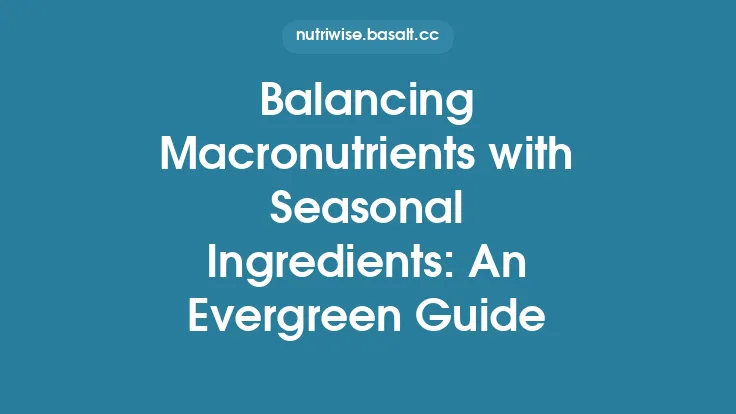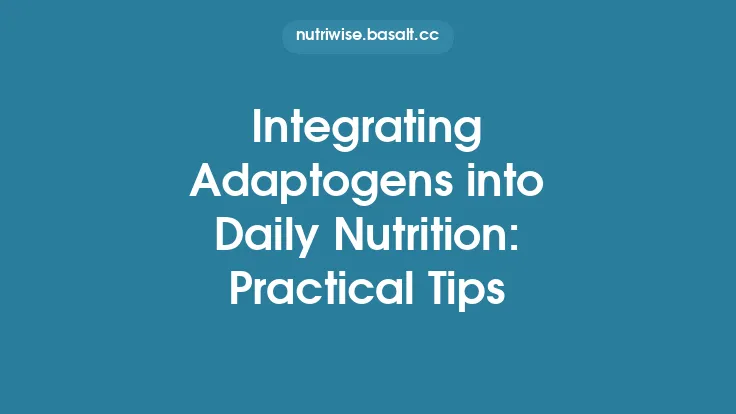Omega‑3 fatty acids—particularly EPA (eicosapentaenoic acid), DHA (docosahexaenoic acid), and ALA (alpha‑linolenic acid)—have become a cornerstone of modern nutrition science because of their profound influence on cardiovascular health, inflammation modulation, and cellular function. While many people know that “eating fish is good for the heart,” the practical challenge lies in weaving these nutrients seamlessly into everyday meals without turning the kitchen into a laboratory. This article walks you through the science, the sources, and the step‑by‑step strategies that let you embed omega‑3‑rich foods into the dishes you already love, ensuring consistent intake without sacrificing flavor, convenience, or budget.
Understanding the Different Forms of Omega‑3
| Form | Primary Food Sources | Key Cardiovascular Benefits |
|---|---|---|
| EPA | Fatty fish (salmon, mackerel, sardines, herring) | Lowers triglycerides, reduces platelet aggregation, improves endothelial function |
| DHA | Fatty fish, algae oil | Supports heart rhythm stability, enhances arterial elasticity, contributes to anti‑arrhythmic effects |
| ALA | Flaxseed, chia seeds, walnuts, hemp seeds, canola oil | Converted (inefficiently) to EPA/DHA; still offers anti‑inflammatory properties and modest triglyceride reduction |
*Why the distinction matters*: EPA and DHA are the “ready‑to‑use” forms that the body can immediately employ in cell membranes and signaling pathways. ALA must be enzymatically converted, a process that is limited (often <10 % for EPA and <5 % for DHA). Therefore, a balanced approach that includes both marine and plant sources maximizes overall omega‑3 status.
Selecting High‑Quality Omega‑3 Ingredients
- Fresh vs. Frozen Fish
- *Fresh*: Best when purchased from reputable fishmongers who turn over stock daily. Look for firm flesh, clear eyes, and a mild sea scent.
- *Frozen*: Often flash‑frozen at peak freshness, preserving EPA/DHA content. Choose products without added sauces or breading to keep the omega‑3 profile intact.
- Algae‑Based Supplements
- Ideal for vegetarians and vegans. Look for products that specify “100 % DHA” and are certified free of heavy metals.
- Seed and Nut Integrity
- Whole flaxseed or chia seeds retain their mucilaginous coating, which protects ALA from oxidation. Ground flaxseed offers better bioavailability but should be stored in airtight containers in the refrigerator.
- Oil Stability
- Omega‑3 oils are polyunsaturated and prone to oxidation. Choose cold‑pressed, dark‑bottled oils (e.g., extra‑virgin flaxseed oil) and keep them refrigerated. Use within 3–4 months after opening.
Cooking Techniques That Preserve Omega‑3s
| Technique | Why It Works | Practical Tips |
|---|---|---|
| Gentle Baking (300‑350 °F / 150‑175 °C) | Low to moderate heat minimizes oxidative breakdown of EPA/DHA. | Place fish on a parchment‑lined tray, add a splash of lemon juice, and bake for 12‑15 min per inch of thickness. |
| Steaming | No direct contact with hot oil; steam’s moisture environment reduces oxidation. | Use a basket over simmering water; steam salmon fillets for 6‑8 min. |
| Poaching in Acidic Broth | Acidic medium (vinegar, wine, citrus) stabilizes fatty acids while imparting flavor. | Simmer fish gently in a broth of white wine, lemon slices, and herbs for 5‑7 min. |
| Quick Sauté (≤2 min) | Short exposure to heat limits degradation; use a high‑smoke‑point oil (e.g., avocado oil) to avoid burning. | Add pre‑cut salmon or sardine pieces to a hot pan, toss with vegetables, and finish in 1‑2 min. |
| Cold‑Prep (No‑Cook) | Raw or minimally processed foods retain 100 % of their omega‑3 content. | Incorporate smoked salmon, canned sardines, or raw chia seeds into salads, wraps, and smoothies. |
*Avoid deep‑frying or prolonged high‑heat roasting* of omega‑3‑rich fish, as temperatures above 400 °F (200 °C) accelerate lipid peroxidation, diminishing the cardioprotective benefits.
Integrating Omega‑3s Into Everyday Meals
1. Breakfast Boosters
- Flaxseed‑Infused Oatmeal: Stir 1 Tbsp of ground flaxseed into cooked oats; add berries and a drizzle of honey for sweetness.
- Chia Seed Pudding: Mix 3 Tbsp chia seeds with 1 cup unsweetened almond milk, a splash of vanilla extract, and let sit overnight. Top with toasted nuts for texture.
- Walnut‑Topped Yogurt: Sprinkle a handful of chopped walnuts onto Greek yogurt; the combination of protein and ALA supports satiety and heart health.
2. Lunch Enhancements
- Sardine Salad: Combine canned sardines (in water or olive oil) with mixed greens, sliced cucumber, cherry tomatoes, and a lemon‑tahini dressing.
- Algae‑Oil Vinaigrette: Whisk 1 tsp algae oil into a classic vinaigrette (vinegar, mustard, herbs) and drizzle over roasted vegetables.
- Flaxseed‑Crusted Turkey Wrap: Mix ground flaxseed with spices, coat turkey slices, and quickly pan‑sear; wrap in a whole‑grain tortilla with avocado and lettuce.
3. Dinner Strategies
- Herb‑Baked Salmon: Top a salmon fillet with a mixture of chopped dill, lemon zest, and a thin layer of mustard; bake as described above.
- Mackerel Stir‑Fry: Debone fresh mackerel, cut into bite‑size pieces, and stir‑fry with broccoli, bell peppers, and a low‑sodium soy‑ginger sauce for 2 minutes.
- Omega‑3‑Rich Grain Bowls: Use quinoa or farro as a base, add roasted vegetables, a scoop of hummus, and a spoonful of hemp seeds for an ALA boost.
4. Snack Solutions
- Roasted Seaweed & Flaxseed Mix: Toss roasted seaweed strips with toasted flaxseed and a pinch of sea salt.
- Nut‑Butter Energy Balls: Blend almond butter, rolled oats, chia seeds, and a dash of cocoa powder; roll into bite‑size balls and refrigerate.
Maximizing Bioavailability
- Pair with Fat‑Soluble Nutrients
- Vitamin E (found in almonds, sunflower seeds) acts as an antioxidant, protecting omega‑3s from oxidative damage during digestion.
- Fat‑soluble vitamins (A, D, K) improve absorption of EPA/DHA when consumed together (e.g., salmon with a side of sautéed kale).
- Avoid Excessive Heat and Light
- Store oils in amber glass bottles; keep them in the refrigerator.
- Use opaque containers for ground seeds to limit exposure to UV light.
- Mind the Cooking Vessel
- Non‑reactive cookware (stainless steel, ceramic) prevents metal leaching that can catalyze oxidation of polyunsaturated fats.
Practical Tips for Consistent Omega‑3 Intake
| Challenge | Solution |
|---|---|
| “I don’t like fish” | Start with milder‑tasting options like canned sardines or smoked trout; incorporate into spreads (e.g., sardine pâté) or salads. |
| Budget constraints | Purchase frozen fish in bulk; use plant‑based sources (flaxseed, chia) which are cost‑effective and shelf‑stable. |
| Time pressure | Keep a “quick‑omega‑3 kit” in the pantry: pre‑ground flaxseed, chia seeds, canned salmon, and a small bottle of algae oil for fast additions. |
| Allergies | For shellfish allergies, focus on plant sources and algae‑derived DHA; consult a dietitian for personalized alternatives. |
| Taste fatigue | Rotate between marine (salmon, mackerel, sardines) and plant (flax, chia, walnuts) sources; experiment with global flavor profiles (e.g., Japanese miso‑marinated salmon, Mediterranean sardine tapenade). |
Sustainability and Ethical Considerations
- Wild‑Caught vs. Farmed: Wild‑caught fatty fish generally have higher EPA/DHA ratios and lower contaminant loads, but overfishing concerns demand responsible sourcing. Look for certifications such as MSC (Marine Stewardship Council).
- Algae Production: Algae‑derived DHA offers a low‑impact, scalable alternative with minimal oceanic footprint. Choose products that are certified organic and non‑GMO.
- Seed Cultivation: Flax and chia are low‑input crops; supporting local growers reduces transportation emissions.
Frequently Asked Questions
Q: How much omega‑3 should I aim for each day?
A: The American Heart Association recommends at least two 3‑oz servings of fatty fish per week, translating to roughly 500 mg EPA + DHA daily. For ALA, a daily intake of 1.1 g for women and 1.6 g for men is suggested. Adjust based on personal health goals and physician advice.
Q: Can I use omega‑3 oils for high‑heat cooking?
A: No. Oils rich in EPA/DHA (e.g., fish oil) have low smoke points and oxidize quickly. Reserve them for dressings, drizzles, or finishing touches. Use high‑smoke‑point oils (e.g., avocado, refined coconut) for searing.
Q: Does cooking destroy all the omega‑3s?
A: Moderate heat (≤350 °F) retains the majority of EPA/DHA. Significant loss occurs only with prolonged, high‑temperature methods (deep‑frying, charbroiling).
Q: Are omega‑3 supplements necessary if I eat fish regularly?
A: Not typically. Whole‑food sources provide additional nutrients (protein, vitamin D, selenium) that supplements lack. Supplements may be useful for individuals with dietary restrictions or specific medical conditions.
Building a Personal Omega‑3 Action Plan
- Inventory: List the omega‑3 foods you already have and note gaps.
- Schedule: Designate at least two meals per week for a marine source and three snack/side options for plant sources.
- Prep: Batch‑prepare seed mixes (ground flax + chia) and store in the fridge for quick addition to smoothies or baked goods.
- Track: Use a simple food diary or a nutrition app to log EPA/DHA and ALA intake, aiming for the recommended thresholds.
- Review: Every month, assess taste preferences, budget impact, and any health markers (e.g., lipid profile) with your healthcare provider.
By understanding the distinct forms of omega‑3s, selecting high‑quality ingredients, employing cooking methods that safeguard their integrity, and weaving them into familiar meals, you can create a sustainable, heart‑supportive eating pattern that feels natural rather than forced. The result is not just a healthier heart, but a more vibrant, flavorful kitchen where nutrition and enjoyment coexist.





